Basant Kite Festival (Punjab)
| Basant | |
|---|---|
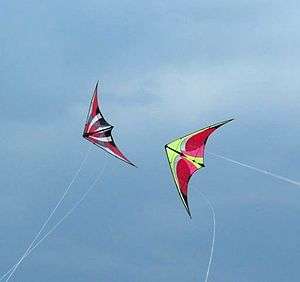 | |
| Official name | Basant Panchami |
| Observed by | All faiths |
| Liturgical Color | Yellow |
| Observances | Kite flying. Eating sweet dishes. Decorating homes with yellow flowers. |
| Date | Magha Shukla Panchami |
| 2016 date | 13 February 2016 Punjab region between Jan-Feb |


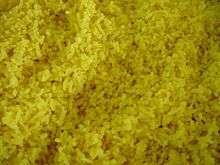
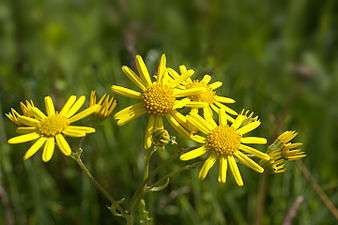

.jpg)
.jpg)
The Basant Kite Festival is a seasonal[1] festival of the Punjab region. It falls on Basant, also called Basant Panchami Punjabi: ਬਸੰਤ ਪੰਚਮੀ; Urdu: بسنت پنچمی; Hindi: बसन्त पञ्चमी) and Vasant Panchami). According to the Punjabi calendar it is held on the fifth day of lunar month of Magha (in late January or early February) marking the start of spring.
Spring time
In North India, and in the Punjab province of Pakistan, Basant is considered to be a seasonal festival and is celebrated as a spring festival of kites by people of all faiths.[2] The festival marks the commencement of the spring season. The festival is summed up in the phrase, Ayi Basant Pala Udant (here comes spring, the cold will disappear). Being seen as a seasonal festival, Punjabis of all faiths have traditionally celebrated Basant.[3]
Basant Kite Festival
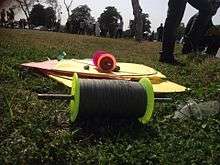
In many parts of India, Basant is observed as a secular holiday, with no celebration attached to it.[2] However, in the Punjab region (including the Punjab province of Pakistan), Basant is celebrated with much gusto and Basant has a distinctive feature. There is a long established tradition of flying kites[4] and holding fairs.
Central/Majha Punjab

Lahore, Amritsar and Kasur are the traditional areas where kite flying festivals are held.[5] A popular Basant Mela is held in Lahore (see Festivals of Lahore). However, the festival has also been traditionally celebrated in areas such as Sialkot, Gujranwala and Gurdaspur.
Historically, Maharaja Ranjit Singh held an annual Basant fair and introduced kite flying as a regular feature of the fairs held during the 19th[6] century which included holding fairs at Sufi shrines.[7] Maharaja Ranjit Singh and his queen Moran would dress in yellow and fly kites on Basant.[8] The association of kite flying with Basant soon became a Punjabi tradition with the centre in Lahore which remains the regional hub of the festival throughout the Punjab region.[9] Indeed Maharaja Ranjit Singh held a darbar or court in Lahore on Basant which lasted ten days during which time soldiers would dress in yellow and show their military prowess.[10] Other traditions of the Basant in Lahore included women swaying on swings and singing.[11]
Malwa, Punjab
The festival of Basant is celebrated across Malwa, Punjab[12] where people organize gatherings to fly kites. In areas such as Firozpur, children generally fly kites to mark the auspicious occasion. A large festival is organized at Gurdwara Dukh Nivaran Sahib, in Patiala. On that day women generally dressed in yellow garments and men wearing yellow coloured turbans join the festival.
A large fair is organised on the day of Basant Panchmi in the Shiv temple of Bansari and Gudri which is located in Dhuri, Sangrur district. The fair includes swings, rides and food.[13]
Doaba Punjab
The ruler of Kapurthala princely state, Maharaja Jagatjit Singh, started the Basant Panchami fair which is now in its 97th year (2014). People attend the fair at Shalamar Bagh wearing yellow clothes and turbans.[14] In Hoshiarpur, a fair is held at the Boeli of Baba Bhandari where thousands of men, women and children participated and pay obeisance at the samadhi of martyr Dharamvir Haqiqat Rai.[14] Basant in the Punjab is associated with Haqiqat Rai who laid down his life to fight for the right of people to follow their religion of choice,[2] in 1742 A.D. on Basant.[15] At the fair held at the Boeli of Baba Bhandari, it is customary to hold kite flying competitions.
Pothohar Plateau
Basant is celebrated in Ralwalpindi, Pakistan with the flying of kites.[16]
Punjab Region
The Basant Kite Festival is popular in many areas of the Punjab region and is celebrated with much fanfare.
Other traditions
.jpg)
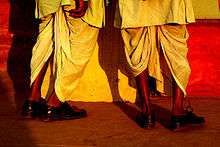
The other traditions are common to other regions celebrating Basant: it is traditional for people to wear yellow. It is also customary to eat rice coloured with saffron. Other sweet dishes include gajjar da halwa and laddo. People decorate their houses with yellow flowers too. These traditions can also be observed in Uttarkashi where Basant is a farmers festival. People pluck yellow flowers and decorate the main doors of the house with it welcoming the spring and the new sowing season.[17]
Basant and Shishir Ritu
The Indian year is divided into six seasons or the 'ritus'. The first season is Vasanta (Ritu) or the spring season, the second is 'Grishma' ritu (summer), the third is the 'Varsha' ritu (monsoon), the fourth is the 'Sharad' ritu (autumn), the fifth is the 'Hemant' ritu (winter)and the sixth or the last is the 'Shishir' ritu (cool season).
Basant Panchami actually falls in the last Shishir (cool) ritu. However, the festival is widely believed to be the start of the spring season. There is no explanation as to why Basant is seen as the start of the spring season. One can only suggest that Basant Panchami marks the end of the Sharad (winter) ritu and prepares people for the imminent arrival of the Vasant (spring) ritu by celebrating Basant during the Shishir (cool) season. An alternative explanation could be that in ancient India, the Vasant ritu occurred in the months of Magha and Phagan (January and February) hence why Basant Panchami is celebrated when it is.
The following table shows the Indian and western months and the corresponding seasons. The calculation is a guide only. Actual determination of the seasons varies between different calendar. In some versions, the Vasanta ritu starts with the new moon in Phalgun which occurs in February. Therefore, it is important to see a calendar.
| Indian lunar calendar month | English month | Season |
|---|---|---|
| Chait | March–April | Vasant Ritu |
| Vaisakh | April–May | Vasant Ritu |
| Jeth | May–June | Grishma Ritu |
| Harh | June–July | Grishma Ritu |
| Sawan | July–August | Varsha Ritu |
| Bhadon | August–September | Varsha Ritu |
| Assu | September–October | Sharad Ritu |
| Katik | October–November | Sharad Ritu |
| Magar | November–December | Hemant |
| Poh | December–January | Hemant |
| Magh | January–February | Shishir |
| Phagan | February–March | Shishir |
Where Maghi is celebrated in the solar month of Magh, Basant is celebrated in the corresponding lunar month of Magh. Both these festivals are seasonal with Maghi being celebrated before Basant.
The Mustard festival
Mustard is planted in September to February during which time the seeds flower and the crop is harvested in March to May.[18] Basant Panchami takes place towards the end of the flowering season and is therefore regarded as a festival related to mustard in the Punjab region.
Basant and religion
Hinduism
The division of the seasons into six categories, called Ritu (Indian season), is detailed in the Veda. Basant Panchami is the day chosen to mark the beginning of the spring season.
Although Basant Panchami is a secular seasonal festival in the Punjab region, other states of India celebrate the day as Sarawati Puja.[19] Accordingly, many educational institutions in the Punjab region perform Saraswati Puja.
Sikhism

The Guru Granth Sahib mentions six seasons[20] and prescribes the singing of verses in accordance with the styles appropriate to the season.[21]
The following is a verse dedicated to Basant:
Basant, Third Mehl: The season of spring has come, and all the plants have blossomed forth. This mind blossoms forth, in association with the True Guru. ||1|| So meditate on the True Lord, O my foolish mind. Only then shall you find peace, O my mind. ||1||Pause|| This mind blossoms forth, and I am in ecstasy. I am blessed with the Ambrosial Fruit of the Naam, the Name of the Lord of the Universe. ||2|| Everyone speaks and says that the Lord is the One and Only. By understanding the Hukam of His Command, we come to know the One Lord. ||3|| Says Nanak, no one can describe the Lord by speaking through ego. All speech and insight comes from our Lord and Master. ||4||2||14.[22]
Accordingly, in the Harmandir Sahib, Amritsar, on the day of Vasant Panchmi, musicians start the music by singing Basant Raga. This practice continues up until the first day of Vaisakh when Basant Rag is no longer used.[23]
Maharaja Ranjit Singh promoted the celebration of Basant in the Gurdwara. In 1825 A.D. he gave 2,000 rupees to the Harmandir Sahib Gurdwara in Amritsar to distribute Karah Parshad.[24]
In Amritsar a fair is held on Basant at Chheharta Sahib Gurdwara in the village of Wadali where Sri Guru Hargobind Ji was born in 1595, to celebrate the birth.[25] The main attraction of Basant at Chheharta Sahib is the kite flying practice which is a very old custom attached to the festival. People fly colorful kites and during the process each of them tries to cut off the other person's kite.
Guru Gobind Singh Ji Sahib got married to Satkaryog Mata Jeeto Ji at Guru Ka Lahore in 1677 on Basant Panchami. Every year a fair[26] and a Nagar Kirtan is held from Guru Ka Lahore to Takhat Sri Kesgarh Sahib celebrating the Anand Karaj of Dasmesh Pita Ji.
Sufi Festival
For Muslims, the festival forms part of the Sufi tradition.
Other parts of India
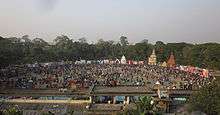
The present trend is to perform Saraswati Puja in educational institutions, taking the lead of the distinct festival celebrated in eastern parts of India, Nepal and Bengal (where it is also known as Sri Panchami). The practice of inaugurating training institutions and new schools was popularised by educationist Pandit Madan Mohan Malaviya (1861-1946), who founded the Banaras Hindu University on Vasant Panchami day in 1916.[27]
In many parts of India and Nepal, people perform prayers in the morning to seek blessings of the Goddess Saraswati. In some regions, on Basant Panchami day, everyone rises early to bathe, dress in yellow clothes, adorn their forehead with the yellow tilak of turmeric, and worship the sun goddess,[28] Mother Ganga, and the earth. Saraswati puja is also performed.
Basant is also associated with the worship of Vishnu, the god of preservation.[2] Basant coincides with the festival of Saraswati Puja[29]
Accordingly, Basant Panchami is a generic term to refer to the two festivals of Basant and Saraswati Puja as they both fall on the same day. The two are interlinked as Basant Panchami is also the birthday of Saraswati.
See also
References
- ↑ "Chapter iii". Punjabrevenue.nic.in. 1930-04-01. Retrieved 2014-02-17.
- 1 2 3 4 The Sikh World: An Encyclopedia Survey of Sikh Religion and Culture: Ramesh Chander Dogra and Urmila Dogra; ISBN 81-7476-443-7
- ↑ The Partitions of Memory: The Afterlife of the Division of India - Google Books. Books.google.co.uk. Retrieved 2014-02-17.
- ↑ Punjabiat: The Cultural Heritage and Ethos of the People of Punjab: Jasbir Singh Khurana
- ↑ Kaul, Suvir (2001) The Partitions of Memory: The Afterlife of the Division of India
- ↑ Camille Mirepoix (1967) Now Pakistan
- ↑ Ansari, Shahab (26 March 2011) The News Festival of Lights kicks off
- ↑ Hasan, Masudul. Unique Women of the World: Being Unique Stories of the Sidelights of the Lives, Loves, and Mysteries of Famous Women of All Times, All the World Over
- ↑ Desai, Nikita (2010) A Different Freedom: Kite Flying in Western India; Culture and Tradition. Cambridge Scholars Publishing
- ↑ The Sikh Courier International, Volumes 33-37
- ↑ Rumi, Raza (10.03.2009) The history of Basant. Lahore Nama
- ↑ "The Tribune, Chandigarh, India - Bathinda Edition". Tribuneindia.com. Retrieved 2014-02-17.
- ↑ Basant Mela 2015
- 1 2 "The Tribune, Chandigarh, India - Jalandhar Edition". Tribuneindia.com. Retrieved 2014-02-17.
- ↑ Pande, Alka (1999) Folk Music & Musical Instruments of Punjab: From Mustard Fields to Disco Lights, Volume 1
- ↑ Aamir Yasin and Mohammad Asghar (14.03.2015) Pindi says ‘Bo Kata’ to kite-flying ban
- ↑ "Celebrating Basant Panchmi, a spring festival in Uttarkashi, India". Anandway.com. Retrieved 2014-02-17.
- ↑ Report of Rapeseed
- ↑ ASPECTS OF PUNJABI CULTURE S. S. NARULA Published by PUNJABI UNIVERSITY, INDIA, 1991
- ↑ Surindar Singh Kohli (1992) A Conceptual Encyclopaedia of Guru Granth Sahib
- ↑ Nikky-Guninder Kaur Singh (2011) Sikhism: An Introduction
- ↑ Sri Granth.org
- ↑ "Musicological Study of Sri Guru Granth Sahib". Sikhreview.org. Retrieved 2014-02-17.
- ↑ Hari Ram Gupta (1991) History of the Sikhs: The Sikh lion of Lahore, Maharaja Ranjit Singh, 1799-1839
- ↑ Johar, Surinder Singh Holy Sikh Shrines
- ↑ Dr. Krishna Gopal, Phal S. Girota (2003) Fairs and Festivals of India: Chandigarh, Delhi, Haryana, Himachal Pradesh, Jammu and Kashmir, Punjab, Rajasthan, Uttaranchal, Uttar Pradesh
- ↑ "Vasant Panchami: Birthday of Goddess Saraswati". Hinduism.about.com. 2014-02-13. Retrieved 2014-02-17.
- ↑ Sun Worship in India: a Study of Deo Sun Shrine: A B Saran, G Pandey
- ↑ "Double dose of celebrations - Times Of India". Articles.timesofindia.indiatimes.com. 2012-01-28. Retrieved 2014-02-17.
| |||||||||||||||||||||||||
| ||||||||||||||
| Wikimedia Commons has media related to Festivals of Punjab. |
